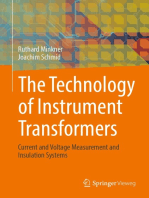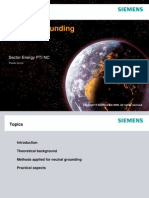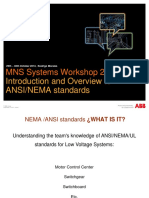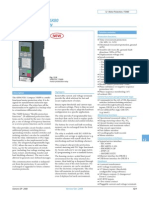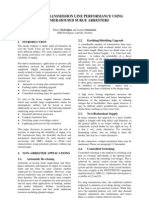Protection CoordinationSiemensInc
Protection CoordinationSiemensInc
Uploaded by
MarcWorldCopyright:
Available Formats
Protection CoordinationSiemensInc
Protection CoordinationSiemensInc
Uploaded by
MarcWorldCopyright
Available Formats
Share this document
Did you find this document useful?
Is this content inappropriate?
Copyright:
Available Formats
Protection CoordinationSiemensInc
Protection CoordinationSiemensInc
Uploaded by
MarcWorldCopyright:
Available Formats
SIEMENS
Power Technology
Power Transmission and Distribution
Issue 102
Protective Relaying
Luis G. Prez, Ph.D. Senior Staff Consultant luis.perez@siemens.com
Control and Protection Power system automation is performed by a variety of devices and subsystems which can be hierarchized. Among these, the system human operators, the automatic control subsystem and the relay protection subsystem lie in the highest levels of the hierarchy. The automatic control and relay protection subsystems monitor the power system behavior on a permanent basis and automatically respond to system disturbances (see Fig. 1). The control system is comprised of generator voltage and speed controls, transformer automatic tap changers, automatically switched reactors and capacitors, FACTS, etc. These devices sensitively react to changes of the power system state variables (commonly voltage and frequency) caused by practically any disturbance. This system is intended to fix the deviation of frequency and voltage caused by relatively minor disturbances, like load connection/disconnection and normal maintenance switching. The control system must be set in order to respond to a series of pre-established design considerations. Power control engineers calculate the control settings with the help of dynamic simulation programs, like PSSE.
Settings
Control
Manual Orders Disturbances
Power System
System Outputs (V, f, P, etc)
Settings
Protection
Protection Hardware and Philosophy The protection system is based on the philosophy of what has been traditionally defined in the United States Figure 1 - The protection system as Protective Relaying. Its main elements are circuit changes the power system to minimize breakers, instrument transformers, protective relays and the impact of severe disturbances [1]. auxiliary devices (see Fig. 2). In medium and low-voltage systems, fuses are also part of the protective hardware. Unlike the control system, the protection system is designed to react primarily to severe disturbances, as in the case of short circuits caused by line insulation breakdowns during a lightning storm. The protection system quickly reacts to disconnect the faulted element (power line, transformer, generator, etc.). The automatic disconnection is achieved with the circuit breakers, which open their high-duty power contacts after receiving an order from the protective relays (see Fig. 2). This disconnection and the consequent extinguishing phenomenon is known as fault clearing. During the time the fault exists, and immediately after its clearance, the power system experiences a series of dramatic changes which may destroy individual components or, in cases where the system dynamics are negatively impacted, may lead to a major system dismembering and, eventually, to wide area blackouts. Protective relays are low-voltage low-current intelligent devices which detect the fault by measuring the current and/or voltage of the system as reflected at the secondary side of specially designed current and voltage transformers (see Fig. 2). The measured phase currents and/or voltages generally have sufficient information to feed a relaying algorithm (or mechanism) which determines the breaker disconnection. Relays are configurable and settable, so it is possible to use the same kind of line protective relay to protect different types of lines; however, there will be different relay settings for each particular
Power Technology
July 2008
application. These relay or protection settings are calculated according to a well established set of criteria. The protection system has to be: (a)sensitive, to detect all faults; (b)fast, to minimize the damage that faults may cause; (c)secure, to avoid operation for non-fault or out of reach disturbances; (d)selective, to strictly disconnect the minimum amount of service to clear the fault; and (e)dependable, to ensure a reliability close to 100%. When a short circuit occurs at some point in the power system, one or more protective relays in the neighborhood of the fault detect the fault; however, only those relays that accomplish conditions (a) to (d) should be allowed to disconnect their corresponding circuit breakers (see Fig. 3). A protection system that simultaneously accomplishes all these characteristics is said to be coordinated. Some relays, called backup relays, are set in a way that their circuit breakers clear a fault in case there is a failure in the operation of the relays originally intended to clear that fault. This system backup type of design redounds in reliability. Protection Coordination
SS Bus Side
Current Transformer
Circuit Breaker
Line Side
52 TC
CB Cabinet
52a
Relay
Voltage Transformer SS Battery
52 TC
(A
= Circuit breaker trip coil
52a = Circuit breaker auxiliary contact
When all the relay designs, schemes and configurations of a protection system are defined, the process of calculating the relay settings in order to make such a system coordinated, as defined in the previous paragraph, is commonly called protection coordination. Engineers perform coordination studies to assure that the protection system works according to the aforementioned philosophy. Protection (B coordination or relay coordination studies are traditionally carried out using short circuit simulation Bus Line programs and relay simulation programs. In traditional Side Side methods, the relay settings are calculated using rules of thumb based on engineers experience: faults are simulated over critical points of the system and the relays behavior is observed for each fault. If no coordination is achieved at one attempt, the process (C must be repeated as many times as needed until the protection system works according to the coordination criteria. Engineers use simulation programs (for Relay example, the protection modules of PSSSINCAL used at Siemens PTI) as a support in the iteration Figure 2 - Protection Hardware process. In some cases, due to the complexity of the A. Simplified scheme of line protection system, the volume of calculations involved is enormous; consequently, engineers cannot find a B. Engineers set the relays satisfactory coordination solution for all the relay C. One-line diagram of (A) settings. There are some (not many) automatic coordination programs that help in this task [2]. Among other characteristics, good automatic coordination programs have to be able to receive practical inputs from the protection engineer in order to adapt to any particular criteria and experience.
Page 2
Power Technology
July 2008
As any power system changes in the short, medium and long term, engineers have to re-calculate the optimum relay settings for each new power system configuration. In other words, coordination studies have to be performed on a regular basis to guarantee proper system performance. Relay coordination and all aspects related to protective relaying represent a continual source of work for the protection engineering specialists. Siemens PTI and Protective Relaying Siemens PTI US has the computer tools and professionals with the experience and skills needed to calculate relay settings and produce the optimum results in protection coordination studies as well as in all other aspects related to protective relaying. Siemens PTI offers the following consulting services in the protection area: Short-circuit calculation and fault analysis Current transformer analysis and dimensioning Dynamic and pseudo-static analysis and setting of electromechanical, solid-state-analog and microprocessor-based protective relays and schemes for transmission, distribution, generation and industrial systems Optimum setting calculation (coordination) of directional overcurrent relays in transmission and subtransmission systems Distance relay setting calculation (coordination) for high-voltage transmission lines Protective relay setting calculation (coordination) for power generators Protective relay setting calculation (coordination) for power transformers and other substation equipment Utility distribution feeder protection coordination using relays, fuses, sectionalizers, and reclosers Industrial system protective relay setting calculation (coordination) Protective relay database design and maintenance Protective relaying is a wide field of knowledge. Everyday, new applications, new situations, new problems to solve and new criteria are born. The list displayed above is just a subset of all the possibilities.
1 5 2 3 6 11 14
10 13
12
7 18 19
8 20
15 21
17 22
16 23
24 25 26 27 29 33 38 34 39 41 35 37 40 F 28 30 31 36 32
42 45
44
43 46
47
Note: This symbol means that the line is radial
Figure 3 - One-line diagram view of the power system and the protection system (only circuit breakers are shown). Example: for a fault at F1, breakers 29 and 35 automatically open in 5 cycles. If 29 failed to operate, then 31 and 26 should trip to clear the fault. This selective mode of operation is part of the whole coordination plan.
References: [1] Prez, L.; Venkatasubramanian, V.; Flechsig, A., Modeling the Protective System for Power System Dynamic Analysis, IEEE Transactions on Power Systems, vol. 9, no. 4, Nov. 1994. [2] Prez, L.; Urdaneta, A., Optimal Coordination of Distance Relays Second Zone Timing in a Mixed Protection Scheme with Directional Overcurrent Relays, IEEE Transactions on Power Delivery, vol. 16, no. 3, Jul. 2001.
Page 3
You might also like
- The Technology of Instrument Transformers: Current and Voltage Measurement and Insulation SystemsFrom EverandThe Technology of Instrument Transformers: Current and Voltage Measurement and Insulation SystemsNo ratings yet
- NPS - 002 - 022 Tech Specs For 66kV Power CablesDocument14 pagesNPS - 002 - 022 Tech Specs For 66kV Power CablesandcrisdanmatNo ratings yet
- CMS 356 Getting Started ENUDocument39 pagesCMS 356 Getting Started ENUDuna FlaviuNo ratings yet
- Neutral Earthing - SiemensDocument77 pagesNeutral Earthing - SiemensArnab Banerjee100% (1)
- Descriptive Bulletin 242-32Document25 pagesDescriptive Bulletin 242-32mashan98No ratings yet
- NuovoPignone-Overhung Centrifugal CompressorsDocument7 pagesNuovoPignone-Overhung Centrifugal CompressorsMarcWorldNo ratings yet
- 01 - Overview of Protection FundamentalsDocument28 pages01 - Overview of Protection FundamentalsM Kumar MarimuthuNo ratings yet
- IEEE-PES PSRC Report On Design and Testing of Selected System Integrity Protection SchemesDocument5 pagesIEEE-PES PSRC Report On Design and Testing of Selected System Integrity Protection Schemesdes1982No ratings yet
- Sepam 10 Seped307026en Int PDFDocument22 pagesSepam 10 Seped307026en Int PDFJeffrey Reynaldo RidwanNo ratings yet
- Ampacity Calculation by Finite Element MethodDocument4 pagesAmpacity Calculation by Finite Element Methodthedt1147No ratings yet
- Current Transformer - Electrical Notes & ArticlesDocument35 pagesCurrent Transformer - Electrical Notes & ArticlesBlake100% (1)
- Screen BondingDocument38 pagesScreen BondingMoataz Eweda100% (1)
- Transformer Differential Protection. Application Guide - Autores Varios - Editorial Alstom - 2003Document40 pagesTransformer Differential Protection. Application Guide - Autores Varios - Editorial Alstom - 2003Manuel OrtegaNo ratings yet
- System Protection SchemesDocument29 pagesSystem Protection SchemesRahul ChakrabartiNo ratings yet
- 1.1Kv Grade Power and Control Cables: SectionDocument9 pages1.1Kv Grade Power and Control Cables: SectionevjbalaNo ratings yet
- Overhead LinesDocument33 pagesOverhead LinesxolraxNo ratings yet
- Medium Voltage MZDocument86 pagesMedium Voltage MZsujiNo ratings yet
- 020-Überblick 8DN9 II - ENGLDocument24 pages020-Überblick 8DN9 II - ENGLMuruganantham ChandrappanNo ratings yet
- System Protection Principles - 12Document18 pagesSystem Protection Principles - 12Daniel Taiti Kimathi100% (1)
- Moeller Consumer Units and The 17 Edition Wiring RegulationsDocument12 pagesMoeller Consumer Units and The 17 Edition Wiring RegulationsArvensisdesignNo ratings yet
- Transformer Earth FaultDocument5 pagesTransformer Earth FaultvyroreiNo ratings yet
- Load Flow Studies On SubstationsDocument40 pagesLoad Flow Studies On Substationsjilanlucky222100% (1)
- Protection of MV LV Substation Transformers PDFDocument37 pagesProtection of MV LV Substation Transformers PDFmatanveer100% (1)
- Paper On Protection CoordinationDocument9 pagesPaper On Protection CoordinationPrudhvi RajNo ratings yet
- Introduction To ANSI StandardsDocument57 pagesIntroduction To ANSI StandardsJorge Luis Mallqui BarbaranNo ratings yet
- Calculo Overhead Ground Wire - OJODocument5 pagesCalculo Overhead Ground Wire - OJOAnonymous V6y1QL6hnNo ratings yet
- ABB DOC User ManualDocument170 pagesABB DOC User Manualkkn1234100% (1)
- Motor Protection 7SK80 SiemensDocument36 pagesMotor Protection 7SK80 SiemensJames Shuanjun Wang100% (1)
- My Ecodial L Technical Documentation V3.4Document166 pagesMy Ecodial L Technical Documentation V3.4nooruddinkhan150% (2)
- Characteristics of Different Power Systems Grounding Techniques: Fact and FictionDocument13 pagesCharacteristics of Different Power Systems Grounding Techniques: Fact and FictionD'há Santos RaúlNo ratings yet
- Design and Operation of EHV Transmission LinesDocument10 pagesDesign and Operation of EHV Transmission LinesAlejandro Ramirez BenitesNo ratings yet
- Coordination and CascadingDocument326 pagesCoordination and CascadingnaderNo ratings yet
- CAB-15-003 Issue 8 With DrawingsDocument23 pagesCAB-15-003 Issue 8 With DrawingsmuratucobanNo ratings yet
- Earth Fault Currents in Three Phase SystemsDocument39 pagesEarth Fault Currents in Three Phase Systemsbxteo100% (1)
- Underground Power Cables: Jatinder Singh 1241084 B.Tech Ee-7 Ctiemt, Shahpur, JalandharDocument42 pagesUnderground Power Cables: Jatinder Singh 1241084 B.Tech Ee-7 Ctiemt, Shahpur, JalandharGopinath B L NaiduNo ratings yet
- Trans Line LADocument8 pagesTrans Line LAsantoshkumarNo ratings yet
- 2017 - 18 Siemens Shortform Catalogue PDFDocument133 pages2017 - 18 Siemens Shortform Catalogue PDFManohar PotnuruNo ratings yet
- Calculation and Analysis of Transformer Inrush Current Based On Parameters of Transformer and Operating ConditionsDocument4 pagesCalculation and Analysis of Transformer Inrush Current Based On Parameters of Transformer and Operating ConditionshnphuocNo ratings yet
- Innovative Substation Design Using Compact SwitchgearDocument11 pagesInnovative Substation Design Using Compact SwitchgearKaJa LaderoNo ratings yet
- Medium Voltage Switchgear GlossaryDocument26 pagesMedium Voltage Switchgear GlossaryVin0% (1)
- Switchgear Safety AspectsDocument20 pagesSwitchgear Safety AspectsMahendra KammaNo ratings yet
- REK28E Oil Immersed Shunt Reactors For 10-400 KV System Voltage 3rd Version (ENG) 4.0 PDFDocument29 pagesREK28E Oil Immersed Shunt Reactors For 10-400 KV System Voltage 3rd Version (ENG) 4.0 PDFSofyanNo ratings yet
- Microsoft Word - Full - Paper-SHEATH - CIRCULATING - CURRENT - CALCULATIONS - AND - MEASUREMENTS - OF - UNDERGROUND - POWER - CABLESDocument4 pagesMicrosoft Word - Full - Paper-SHEATH - CIRCULATING - CURRENT - CALCULATIONS - AND - MEASUREMENTS - OF - UNDERGROUND - POWER - CABLESsaghaee.rezaNo ratings yet
- 01 Network ConfigurationsDocument48 pages01 Network ConfigurationsRazvan MaresNo ratings yet
- Pre-Commissioning Tests For Power Cable R3Document18 pagesPre-Commissioning Tests For Power Cable R3Fahimuddin QureshiNo ratings yet
- XLPE Land Cable Systems - User S GuideDocument28 pagesXLPE Land Cable Systems - User S GuideJeremy Mcfadden100% (1)
- Abb Technical Guide Us102 Motor Cable LengthsDocument32 pagesAbb Technical Guide Us102 Motor Cable LengthsCristhJuliangNo ratings yet
- Grid-Integrated and Standalone Photovoltaic Distributed Generation Systems: Analysis, Design, and ControlFrom EverandGrid-Integrated and Standalone Photovoltaic Distributed Generation Systems: Analysis, Design, and ControlNo ratings yet
- Power System RelayingDocument22 pagesPower System RelayingKhairul AshrafNo ratings yet
- Protection SettingsDocument33 pagesProtection SettingsirfanWPK100% (1)
- Power System Protection PDFDocument12 pagesPower System Protection PDFBala MNo ratings yet
- Protection, Discrimination and Restricted Earth Fault (REF) StudiesDocument4 pagesProtection, Discrimination and Restricted Earth Fault (REF) Studiescloobpsp100% (1)
- SCHNEIDER Protection Guide 2008Document76 pagesSCHNEIDER Protection Guide 2008Snejana Vasileva100% (1)
- Eng-Function Based Optimized-Mohamed AfifiDocument14 pagesEng-Function Based Optimized-Mohamed AfifiImpact JournalsNo ratings yet
- SCHNEIDER - Guide - Electrical ProtectionDocument76 pagesSCHNEIDER - Guide - Electrical ProtectionWilliam MarquesNo ratings yet
- Relay Coordination 1 PDFDocument5 pagesRelay Coordination 1 PDFNikhil SainiNo ratings yet
- Sahil's Part Electrical DesignDocument6 pagesSahil's Part Electrical DesignmohammedsahilmakraniNo ratings yet
- Control and Protection of Hydro Electric Power PlantDocument181 pagesControl and Protection of Hydro Electric Power PlantMd Abdul Raheman33% (3)
- Enzo Ferrari Owner's ManualDocument296 pagesEnzo Ferrari Owner's ManualRobin97% (29)
- Paper Manufacturing Technology by VoithDocument76 pagesPaper Manufacturing Technology by VoithMarcWorldNo ratings yet
- Marine Energy ReportDocument28 pagesMarine Energy ReportMarcWorldNo ratings yet
- Catalogo Inyectoras ENGELDocument15 pagesCatalogo Inyectoras ENGELMarcWorldNo ratings yet
- CEA Report On Failure of 220KV & Above Voltage Class Substation Equipment, Dec.2013Document31 pagesCEA Report On Failure of 220KV & Above Voltage Class Substation Equipment, Dec.2013MarcWorldNo ratings yet
- Advanced Manufacture ICAM 2010 SEM Taipei Conference ProgramDocument152 pagesAdvanced Manufacture ICAM 2010 SEM Taipei Conference ProgramMarcWorldNo ratings yet
- Senpro Gebäudetechnik 2009 Eng KatalogDocument95 pagesSenpro Gebäudetechnik 2009 Eng KatalogMarcWorldNo ratings yet
- Oil & Gas Application Guide INFED106006EN-Schneider-ElecDocument36 pagesOil & Gas Application Guide INFED106006EN-Schneider-ElecMarcWorldNo ratings yet
- Robinair Bombas de Vacío 15401 601Document32 pagesRobinair Bombas de Vacío 15401 601MarcWorld100% (1)
- SML Technology Report 2. Edition 2010 Druckversion v. 12.10.10 SaveDocument0 pagesSML Technology Report 2. Edition 2010 Druckversion v. 12.10.10 SaveMarcWorldNo ratings yet
- Cokemaking Technology (Table of Contents)Document1 pageCokemaking Technology (Table of Contents)MarcWorldNo ratings yet
- VoithDrive-624 e VP Voithdrive enDocument6 pagesVoithDrive-624 e VP Voithdrive enMarcWorldNo ratings yet
- Cls Shootingbrake Advantages Print 404486.en - Ece.mbDocument40 pagesCls Shootingbrake Advantages Print 404486.en - Ece.mbMarcWorldNo ratings yet
